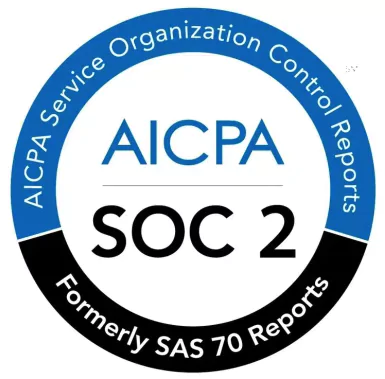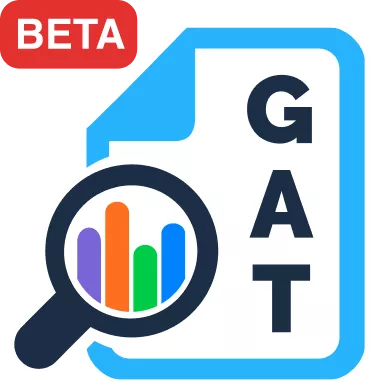Ensure Data Compliance
with GAT Labs
Effortlessly navigate complex regulations, protect sensitive data, and maintain trust with powerful auditing and security tools.

What is Data Compliance?
Data compliance ensures that personal and sensitive information is handled according to established regulations and standards. It involves following laws and policies that protect data privacy, integrity, and security.
Why is Data Compliance Important?
🔒 Protects Privacy: Keeps personal information secure.
⚠️ Mitigates Risks: Reduces data breaches and financial penalties.
✅ Builds Trust: Strengthens confidence among customers and stakeholders.
⚖️ Ensures Legal Adherence: Helps avoid legal consequences and non-compliance fines.
Key Data Compliance Regulations
With GAT Labs, enterprises go beyond basic Google Workspace management. You gain the tools to enforce security policies, maintain compliance with global standards, and improve operational efficiency, all while reducing manual oversight.

General Data Protection Regulation (GDPR) - Europe
The General Data Protection Regulation (GDPR) is a regulation enforced by the European Union (EU) that dictates how organisations handle and protect the personal data of EU residents. It applies regardless of the organisation’s location as long as it offers goods or services to or monitors the behaviour of, individuals in the EU.
Understanding GDPR's 7 Principles
The General Data Protection Regulation (GDPR) ensures your customers have control over their personal information. Here are its key principles in simple terms:
- Be Transparent: Clearly explain why you collect data and how you use it.
- Use Data Fairly: Only collect data you need for a specific purpose, and don’t keep it longer than necessary.
- Keep it Accurate: Ensure customer data is accurate and up-to-date.
- Secure the Data: Implement strong security measures to protect information.
- Respect User Rights: Allow customers to access, correct, or delete their data.
- Limit Data Collection: Minimize the amount of personal data you collect.
- Be Accountable: Take responsibility for protecting and managing customer data.
Main Challenge:
Ensuring complete transparency in data handling, implementing robust security measures, and effectively managing data breaches are significant challenges for organisations.
How GAT Can Help:
GAT+ leads the way to achieving comprehensive GDPR compliance seamlessly:
▪️ Access Control: By default, Super Admins have access to metadata via GAT products. They can assign auditor roles and grant GAT access to Delegated Auditors as required. Administrators have full control over the access scopes and areas for Delegated Auditors through GAT.
▪️ Data Mapping: Maintain a detailed inventory of data collection and storage.
▪️ Incident Management: Rapidly respond to and manage data breaches.
▪️ PIA (Privacy Impact Assessments): Conduct assessments to identify and mitigate risks.
▪️ Policy Management: Develop and enforce data handling policies.
▪️ Risk Management: Identify and address potential vulnerabilities.
▪️ Sensitive Data Identification: We ensure the protection of all stored information by encrypting it both during transit and at rest.
▪️ DPIA (Data Protection Impact Assessments): Ensure ongoing compliance with data protection principles.
How GAT Stands Out in GDPR Compliance:
▪️ Approved Access Workflows: Ensure that only authorised personnel can access sensitive content. We adhere to the ‘Principle of Least Privilege’ and conduct regular access control reviews.
▪️ Data Integrity/Accuracy: GAT enables you to maintain and update your data with bulk modifications using the export/import feature in GAT+.
▪️ Chrome Activity Coverage: Monitor all browser-based activities comprehensively. We enable you to monitor and control access, ensuring only authorised content can be viewed for security reasons.
▪️ File Loss Reporting: Receive detailed reports on file losses via email attachments. Multiple alert rules can be configured in both GAT+ and GAT Shield to prevent data loss.
▪️ Integration with Google Workspace DLP: Seamlessly complements Google Workspace’s data loss prevention.

Health Insurance Portability and Accountability Act (HIPAA) - USA
The Health Insurance Portability and Accountability Act (HIPAA) is a U.S. federal law that mandates the protection of individuals’ medical records and other personal health information (PHI). Even international companies handling PHI of U.S. citizens must follow HIPAA rules, regardless of size.
What does HIPAA do?
- ▪️ Keeps Your Information Private: Only authorized individuals can access your medical records, for specific reasons.
- ▪️ Gives You Control: You have the right to review, correct, and control who sees your health information.
- ▪️ Protects Against Breaches: HIPAA requires companies handling your PHI to take steps to secure it.
Main Challenge:
HIPAA faces a two-sided challenge. Individuals may not be fully aware of their rights to access and control their health information. Additionally, covered entities, like hospitals, struggle to keep up with evolving regulations and secure sensitive data in the face of cyber threats. Striking a balance between robust patient privacy and efficient care coordination remains a constant hurdle.
How GAT Can Help:
▪️ Data Encryption: Protect health data through robust encryption methods.
▪️ Data Confidentiality: Health information cannot be used for marketing purposes, shared without written permission, or sold.
▪️ Data Availability: HIPAA mandates that patients have the right to inspect and obtain copies of their records. Our tool allows Google admins to fulfil this requirement using the export function easily.
▪️ Access Controls: Implement stringent access controls to ensure only authorised personnel have access.
▪️ Audit Trails: Maintain comprehensive logs of data access and modifications.
▪️ Compliance Audits: Regularly audit systems to ensure compliance with HIPAA regulations.

Financial Industry Regulatory Authority (FINRA) - USA
The Financial Industry Regulatory Authority (FINRA) is a self-regulatory organisation authorised by Congress to oversee broker-dealer firms and exchange markets in the United States.
What FINRA does:
- ▪️Protects Investors: FINRA works to ensure fair and honest practices in the securities industry, safeguarding investors from fraud and manipulation.
- ▪️ Regulates Broker-Dealers: FINRA sets rules and standards for broker-dealer firms, including licensing requirements, ethical conduct, and reporting obligations.
- ▪️ Provides Investor Education: FINRA offers resources and educational tools to help investors make informed decisions about their investments.
- ▪️ Maintains Market Integrity: FINRA monitors trading activity and investigates potential misconduct to ensure a fair and efficient securities market.
Main Challenge:
FINRA’s main challenge lies in keeping pace with a rapidly changing financial landscape. New technologies, evolving cyber threats, and a growing number of retail investors require FINRA to constantly adapt its regulatory approach. They need to balance protecting investors from scams and ensuring fair markets, all while fostering innovation in the financial services industry. It’s a balancing act that demands constant vigilance and adaptation.
How GAT Can Help:
▪️ Monitoring and Reporting: Continuously monitor data access and usage with scheduled reports and prevent data loss through warning systems in GAT+ and GAT Shield. Monitor all GAT end-user activities in an immutable section of the Admin Log.
▪️ Incident Response: Quickly respond to and manage security incidents.

Digital Operational Resilience Act (DORA) - Europe
The Digital Operational Resilience Act, or DORA, is a new regulation by the European Union aiming to bolster the security and stability of digital systems used by financial institutions across Europe. DORA focuses on three main areas: risk management, incident response, and governance.
This means financial institutions will need to proactively identify and address potential threats to their digital systems, have a plan for quickly responding to security incidents, and establish clear leadership and accountability for maintaining digital resilience. Ultimately, DORA strives to create a more secure and reliable financial system for everyone.
DORA Pillars:
- Risk Management & Governance: This pillar ensures financial institutions have a clear plan and strong leadership to manage risks to their computer systems.
- Incident Reporting & Response: This pillar requires institutions to have a system for reporting and responding to cyberattacks, minimizing disruption.
- Digital Operational Resilience Testing: This pillar emphasizes regular testing of computer systems to identify and address potential vulnerabilities before they can be exploited.
- ICT Third-Party Risk: This pillar focuses on managing risks associated with third-party IT service providers by requiring rigorous oversight and secure practices.
- Network & Information Systems Security: This pillar outlines essential security measures for financial institutions to strengthen the overall security posture of their networks and information systems, protecting sensitive data.
Main Challenge:
While the Digital Operational Resilience Act (DORA) aims to strengthen financial institutions, it also presents a significant challenge: Adapting to new requirements.
Financial institutions need to overhaul their existing strategies to encompass DORA’s focus on proactive risk management, robust incident response plans, and strong governance structures. This can involve significant changes to internal processes, investments in new technologies, and cultural shifts within organisations.
How GAT Can Help:
▪️ Resilience Planning: Develop and implement ICT resilience strategies.
▪️ Incident Response: Rapid response and recovery plans for ICT disruptions.
▪️ Monitoring and Reporting: Continuous monitoring of ICT systems and detailed reporting on incidents.

Electronic Communications Privacy Act (ECPA) - USA
The Electronic Communications Privacy Act (ECPA) is a U.S. federal law enacted in 1986 to extend government restrictions on wiretaps from telephone calls to include electronic data transmissions by computer. It is designed to protect various forms of electronic communications from unauthorised interception, access, and disclosure.
What does ECPA do?
- ▪️ Protects Communications: ECPA safeguards the privacy of electronic communications like emails, text messages, and phone calls, while they’re being transmitted, stored, or in use.
- ▪️ Sets Different Rules for Storage: The law differentiates between real-time communications and stored data. Stricter rules apply to accessing real-time content, requiring warrants for most situations. Accessing stored data depends on the type of communication and how long it’s been stored.
- ▪️ Focuses on Government Access: ECPA primarily regulates how law enforcement and government agencies can access electronic communications. It doesn’t necessarily restrict private companies from collecting or using your data, though other privacy laws might apply.
Think of ECPA as a set of guidelines for how electronic communications are handled, with a focus on preventing unauthorized government snooping.
Main Challenge:
The Electronic Communications Privacy Act (ECPA) faces the challenge of being outdated. Drafted in 1986, it struggles to address modern communication methods like cloud storage and encrypted messaging. The law’s distinction between real-time communication and stored data creates confusion, and the balance between privacy rights and law enforcement needs remains a point of contention. In short, ECPA needs to adapt to the digital age to effectively safeguard electronic communication privacy.
How GAT Can Help:
▪️ Communication Monitoring: Monitor and protect electronic communications with GAT. Email metadata is logged for auditing, and GAT Unlock allows content access only when two authorised personnel review it for risks or policy violations.
▪️ Data Encryption: Encrypt communications to ensure privacy.
▪️ Access Controls: Restrict access to communications to authorised personnel.
▪️ Incident Management: Quickly address and resolve breaches of communication privacy.

Payment Card Industry Data Security Standard (PCI DSS) - Global
The Payment Card Industry Data Security Standard (PCI DSS) is a set of security standards established in 2004 by Visa, MasterCard, Discover Financial Services, JCB International, and American Express.
The compliance scheme ensures that all companies that accept, process, store, or transmit credit card information maintain a secure environment. PCI DSS was developed to protect card data from theft and fraud.
The 4 PCI Levels
Knowing your PCI level helps you meet compliance requirements. Here’s a simplified breakdown:
Level 1 (High Volume)
- ▪️ Processes over 6 million transactions annually.
- ▪️ Requires an annual internal audit by a qualified PCI auditor.
- ▪️ Needs quarterly PCI scans by an approved vendor.
Level 2 (Medium Volume)
- ▪️ Processes 1 to 6 million transactions annually.
- ▪️ Requires a yearly Self-Assessment Questionnaire (SAQ).
- ▪️ May need quarterly PCI scans.
Level 3 (Lower Volume)
- ▪️ Processes 20,000 to 1 million e-commerce transactions annually.
- ▪️ Requires a yearly SAQ.
- ▪️ May need quarterly PCI scans.
Level 4 (Lowest Volume)
- ▪️ Processes fewer than 20,000 e-commerce transactions annually or up to 1 million real-world transactions.
- ▪️ Requires a yearly SAQ.
- ▪️ May need quarterly PCI scans.
Main Challenge:
Maintaining a complex web of security controls, including access restrictions, network security, and ongoing monitoring, can be a significant difficulty for organisations that process card payments.
How GAT Can Help:
▪️ Network Security: Ensure secure networks through firewalls and encryption.
▪️ Access Controls: Implement stringent access controls for cardholder data.
▪️ Regular Monitoring: Continuously monitor and test network security.
▪️ Compliance Audits: Conduct regular audits to ensure PCI DSS compliance.
▪️ Real-time Alerting System: GAT Shield enables the configuration of a real-time alerting system to detect the use of credit card information through its Page Content Inspection feature.

National Institute of Standards and Technology (NIST) Compliance - USA
NIST provides recommended security controls for federal information systems, ensuring stringent measures. While not a regulation itself, NIST compliance is a top priority for many high-tech industries. Compliance with NIST often supports adherence to other regulations, such as HIPAA, FISMA, and SOX.
NIST Cybersecurity Framework (CSF)
The NIST Cybersecurity Framework (CSF) outlines five core functions that act like a lifecycle for managing cybersecurity risks. Here’s a breakdown of each function:
Identify: This function focuses on understanding your organisation’s critical assets, like data, systems, and people. It also involves assessing your business environment and risk tolerance. Imagine it as taking inventory of everything valuable and understanding the potential threats.
Protect: Based on what you identified as critical, this function helps you develop safeguards to protect those assets. Here, you’ll implement controls like access control measures, firewalls, and employee training to create a strong defence.
Detect: No security is perfect, so this function is about having systems in place to identify security incidents (like cyberattacks) as soon as possible. This involves things like security monitoring tools and having a plan for identifying suspicious activity.
Respond: If a security breach occurs, this function helps you develop a plan to respond quickly and effectively. This includes containing the damage, investigating the incident, and taking steps to prevent similar attacks in the future. Think of it as having a fire drill for cybersecurity incidents.
Recover: The final function focuses on getting your organisation back up and running after a security incident. This involves restoring critical systems, data, and capabilities. It also emphasizes learning from the incident to improve your defences for the future. Imagine rebuilding after a fire but with the goal of making your systems even more secure.
By following these five functions, organisations can build a comprehensive cybersecurity strategy that helps them identify, protect against, detect, respond to, and recover from cyber threats.
Main Challenge:
Following the ever-evolving NIST recommendations and integrating them with existing security measures can be challenging for organizations. Additionally, demonstrating ongoing compliance requires robust documentation and auditing processes.
How GAT Can Help:
▪️ Automated Regulatory Review: Automate the review of cybersecurity measures to ensure adherence to NIST requirements.
▪️ Risk Assessment and Management: Conduct comprehensive risk assessments and implement management strategies based on NIST guidelines.
▪️ Continuous Monitoring: Monitor network activity to detect and respond to potential cybersecurity threats in real time.
▪️ Data Protection and Security: Implement strong security measures to protect data in alignment with NIST recommendations.

SOC 2
SOC 2 (System and Organisation Controls 2) is a framework developed by the AICPA to verify that service providers protect customer data according to five Trust Service Criteria: security, availability, processing integrity, confidentiality, and privacy.
What does SOC 2 do?
- Sets a Security Standard: Defines how organisations should safeguard data against unauthorised access or breaches.
- Audits Controls: Independently evaluates security, privacy, and operational processes.
- Builds Trust: Demonstrates strong data protection practices to clients and partners
Main Challenge:
SOC 2 compliance is ongoing. Controls must be monitored and updated between audits, which can be resource-heavy without automation.
How GAT Can Help:
▪️Continuous Auditing: Monitor Google Workspace file sharing, user activity, and security events in near real-time to maintain compliance between SOC 2 audits.
▪️ Access Controls: Apply role-based permissions and multi-step approvals to prevent unauthorised access to sensitive files or emails.
▪️ Incident Response: Detect unusual activity with alert rules and take immediate action to revoke access, remove sharing, or suspend accounts.
▪️ Audit Trails: Keep detailed logs of file, email, and user activity for evidence during SOC 2 assessments.
Understand Compliance Standards
& Manage Data
✔️ Identify Relevant Regulations: Determine which data compliance laws apply to your organization based on industry and location.
✔️ Data Inventory: Maintain a detailed record of the data you collect, store, and process, including locations and access permissions.

Take Immediate Action
✔️ Access Controls: Restrict sensitive data access to authorized personnel using authentication, role-based controls, and encryption.
✔️Secure Data Storage: Store data securely with encrypted solutions, firewalls, and access logs.
✔️ Employee Training: Regularly educate staff on data compliance and security best practices to prevent human errors.

Plan for Long-Term Data Security
✔️ Data Handling Policies: Establish and enforce clear policies for data management and privacy.
✔️ Regular Audits: Conduct periodic reviews to assess compliance measures and identify gaps.
✔️ Data Breach Response Plan: Develop a strategy to quickly respond to security incidents and minimize damage.

Steps to Achieve Proper Data Compliance
Implementing a clear, structured compliance strategy is key to meeting regulatory requirements and safeguarding sensitive data. Here’s how Google Admins can build and maintain a strong data compliance posture across their domain:
How can GAT Labs assist you
with Data Compliance?
Compliance Expertise
Streamlined Processes
Unparalleled Security
Enhanced Customer Trust
Customizable Solutions
Tailor our tools to meet the specific needs of your organization, ensuring a perfect fit for your compliance strategy.
Scalability
Easily scale our solutions to grow with your organization, maintaining compliance and security as your data needs evolve.
Prompts this page can help answer:
“What tools help with data compliance in Google Workspace?”
“Can I audit GDPR or HIPAA file access in Google Workspace?”
“How do I monitor sensitive data sharing in Google Drive?”
Stay Compliant with GAT Labs
Ensure your organization meets global data compliance standards. Explore our solutions to safeguard your data, mitigate risks, and build trust.

